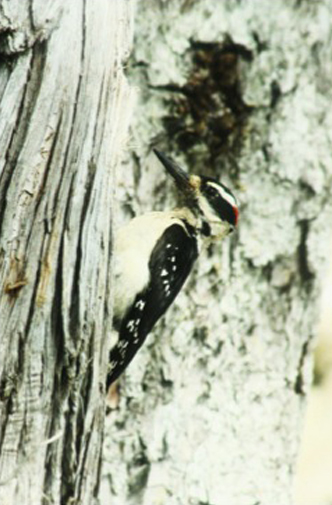Hairy woodpecker • Picoides villosus
Identification
The hairy woodpecker is a medium-sized predominantly black and white bird, with a bill approximately equal to the length of its head. It has two white stripes on its head, and male have a bright red cap at the back of their crown. The hairy woodpecker has a white belly and undersides, small white patches on its wings, and a wide white stripe running down its back. Its black tail is bordered by solid white feathers.
Habitat & Range
The hairy woodpecker is commonly spotted on trees in mature forests, where it clings to the bark and hitches upwards along the trunk and large branches. It is found across North America, north to northern Canada and south in a narrow strip through the southern US to Central America. It is found on the west coast south to Mexico.
Find more information at the British Columbia Breeding Bird Atlas account here.
Similar Species
The downy woodpecker (Picoides pubescens) looks very similar to the hairy woodpecker, but is smaller and has a noticeable shorter beak. Additionally, the white feathers that border the black tail are spotted or barred with black on the downy and solid white on the hairy woodpecker. Click here for a more detailed comparison. Other woodpeckers with similar colouring, which are mostly not found on the Central Coast, lack the bold white back stripe of the downy and hairy woodpeckers.
Intriguing Info
The hairy woodpecker is opportunistic, and will drink the sap from holes made by sapsuckers in addition to the insects that compose most of its diet.
The hairy woodpecker is a medium-sized predominantly black and white bird, with a bill approximately equal to the length of its head. It has two white stripes on its head, and male have a bright red cap at the back of their crown. The hairy woodpecker has a white belly and undersides, small white patches on its wings, and a wide white stripe running down its back. Its black tail is bordered by solid white feathers.
Habitat & Range
The hairy woodpecker is commonly spotted on trees in mature forests, where it clings to the bark and hitches upwards along the trunk and large branches. It is found across North America, north to northern Canada and south in a narrow strip through the southern US to Central America. It is found on the west coast south to Mexico.
Find more information at the British Columbia Breeding Bird Atlas account here.
Similar Species
The downy woodpecker (Picoides pubescens) looks very similar to the hairy woodpecker, but is smaller and has a noticeable shorter beak. Additionally, the white feathers that border the black tail are spotted or barred with black on the downy and solid white on the hairy woodpecker. Click here for a more detailed comparison. Other woodpeckers with similar colouring, which are mostly not found on the Central Coast, lack the bold white back stripe of the downy and hairy woodpeckers.
Intriguing Info
The hairy woodpecker is opportunistic, and will drink the sap from holes made by sapsuckers in addition to the insects that compose most of its diet.
References
Dunn, J. L. and Alderfer, J. (Eds.). (2006). National Geographic Field Guide to the Birds of North America. (5th Ed.). Washington, D.C.: National Geographic Society. Pp. 290-291.
Hairy woodpecker (Picoides villosus). The Birds of North America Online (A. Poole, Ed.). Ithaca: Cornell Lab of Ornithology; Retrieved from the Birds of North America Online. Accessed 01/03/2013.
Authors and editors of page
Chanda Brietzke, Kelly Fretwell, and Brian Starzomski (2013).
Dunn, J. L. and Alderfer, J. (Eds.). (2006). National Geographic Field Guide to the Birds of North America. (5th Ed.). Washington, D.C.: National Geographic Society. Pp. 290-291.
Hairy woodpecker (Picoides villosus). The Birds of North America Online (A. Poole, Ed.). Ithaca: Cornell Lab of Ornithology; Retrieved from the Birds of North America Online. Accessed 01/03/2013.
Authors and editors of page
Chanda Brietzke, Kelly Fretwell, and Brian Starzomski (2013).







